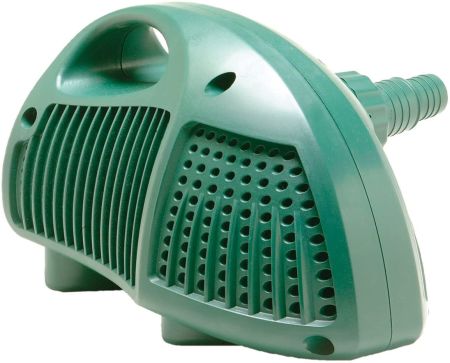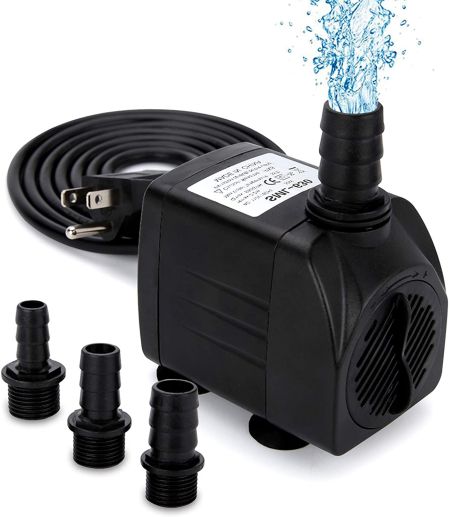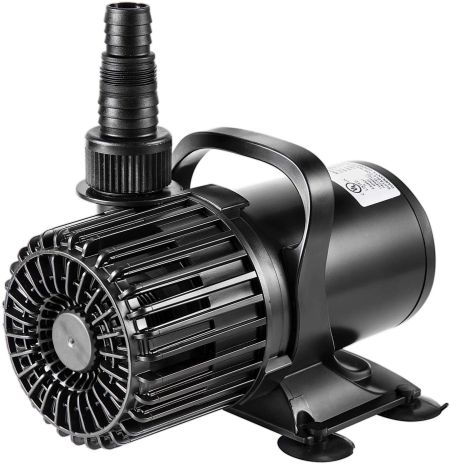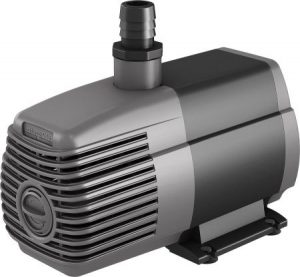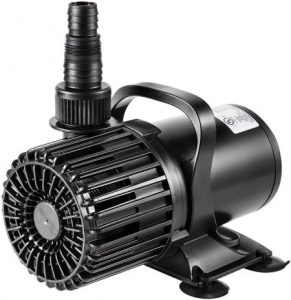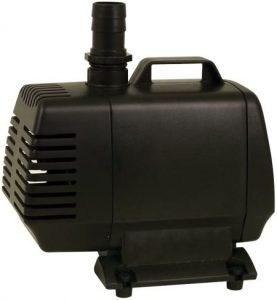8 Best Pond Pump Reviews – Keep Your Pond Crystal Clear
While a pond on the property adds to the landscape, it has its own problems. After a while, the water stagnates, and the oxygen levels become dangerously low. This, too makes it more difficult to maintain the fish and marine life you keep in the pond. You need to keep the water moving and splashing. What you need is a pond pump.
Naturally, you’d want your pond to be teeming with life. Not just fish but also plants, birds, and butterflies as well. You’d want the water in the pond to remain crystal clear all year round and the water surface to break in ripples and waves all the time. A pond pump does that for your pond and more. It keeps the water churning in the pond, which prevents algae buildup. It pumps oxygen into the water to keep the fish healthy.
A pond pump is especially important if you happen to have koi and goldfish. They like to swim in moving water, and they splash around the pond. However, if the water is polluted or murky, the fish might be prone to diseases.
So how would you use a pond pump, and which type to choose? We tested a bunch of pond pumps, so you don’t have to and put together these best pond pump reviews. Our buying guide at the end gives you a clear idea about the key features to look for and answers your pond pump-related questions.
Best Pond Pump Reviews
These are the top pond pump reviews we have tested. As usual, we start with our editor’s choice.
1. Editor’s Choice: Active Aqua Submersible Water Pump
A submersible water pump that combines a smart design with powerful deep water circulation. The Active Aqua Submersible Water Pump is the beating heart of most hydroponic systems. And by that, we mean it creates circulating underwater currents to oxygenate the water and prevent algae buildup. If you had trouble feeding your goldfish or koi because the fish food stays in one place, creating opportunities for conflict, the Active Aqua solves this problem. It keeps the water in the pond in constant movement to disperse the nutrients and deliver them to every part of the pond.
That smart design makes it easy for you to dismantle the pump, give it a thorough cleaning, and put it back together. The whole process doesn’t take more than an hour tops. And you don’t have to be a DIY expert to perform this crucial maintenance task that prolongs the pump’s life and keeps it in good condition.
Another thing we liked about the Active Aqua is its ability to draw water from the bottom and push it to the top. This prevents parts of the pond from becoming stagnant and murky, where poor oxygen levels make them uninhabitable. It also comes in handy when you want to empty up a water tank or a reservoir. The bottom adapters make sump pumps redundant as they pick up the last drop of water at the bottom.
But despite all of these powerful features, the pump has a few drawbacks. One of them is its high noise output. Even totally submerged underwater, the pump makes a racket. This could disturb the fish in the water as well as the humans outside of the water.
Pros
- Smart design.
- Weighs 1.6 pounds in total.
- Bottom adapters for circulating water efficiently.
- 1110 gph capacity.
- Suitable for most hydroponic systems.
Cons
- The pump gets noisy, which could disturb the fish in the pond.
2. Budget Value: VIVOSUN 1600 GPH Submersible Water Pump
Just because you need a pump for your pond or water garden doesn’t mean you have to break the bank to get one. And the VIVOSUN 1600 GPH Submersible Water Pump is a good example of a solid pond pump that comes at an affordable price.
Behind the durability and solid construction of the Vivosun is silicon carbide. It’s a material known for its strength and resistance to erosion. Both the shaft and the drive ring piece are made from this military-grade material. This increases the pump’s life and gives you a few extra years of service.
The powerful motor has a 1600 gph capacity. That allows it to move the whole water volume of a medium-sized pond in one hour or less. You can use this pump on a pond averaging anything between 3000 gallons to 5000 gallons.
But extra power doesn’t mean more noise. This submersible water pump only outputs 40 dB when running at full capacity. That exceptionally low noise will not disturb the fish in the pond or give you a headache.
Another feature we liked about this pump is how easy it is to install it and get it started without constantly consulting the manual. The portable handle and detachable filter make it easy to adjust and install no matter how deep or shallow your pond is. You can adjust the lift height to up to 13.7 feet, which means it will definitely break the surface of the water and create waves in the pond.
One disadvantage we found with this pump is that the fans get clogged easily. Both debris and algae in the pond tend to stick to the inside of the intake casing. You’ll need to power off the pump to clean the filter system a few times and make sure there’s enough space behind the pump to create a flow.
Pros
- Solid pump with parts made from silicon carbide.
- High capacity with 1600 gph.
- Low noise output averaging 40db.
- Affordable price.
Cons
- The filter system tends to clog if too many algae in the water or the debris are too large.
3. Premium Pick: TetraPond Water Garden Pump
When you’re looking for the right pump for your pond, you will consider the pump’s flow performance, the quality of the filter, and the waterfall width. These are the qualities where the TetraPond Water Garden Pump excels. It combines power with a compact size to make it a suitable pump for medium to large ponds.
With a powerful magnetic drive, this pump would power small waterfalls and fountain heads easily and efficiently. The TetraPond pump comes with two adapters. This allows you to fit it on any pond size and pumping heights. You can install it on either a half-inch tubing or a three-quarter inch tubing in diameter.
But it’s the power of the water flow that really makes this pump stand out. It can pump around 1,900 gallons per hour (gph). So if you have a 3,000-gallon pond, this pump will circulate the entire water content in less than a couple of hours. It removes debris, cleans the pond, and oxygenates the water.
The magnetic drive is also energy efficient. This pump consumes less energy than other pumps in the same category. Since you’ll be running the pump for a considerable long time to keep the water in the pond moving and prevent algae, this energy efficiency will save you money in the long run. The pump also comes with a 3-year warranty which is a testament to its good quality, high performance, and durability.
On the downside, we notice a high noise output when the pump is running at full capacity. Unfortunately, there’s nothing you can do about that noise. No amount of adjustment to the position or height of the pump will reduce the noise. It’s just something you have to live with.
Pros
- Energy-efficient magnetic drive.
- Have 1,900 gph capacity.
- 3-year warranty.
- Suitable for 3,000-gallon ponds and above.
- Circulates the volume of the pond in a couple of hours.
Cons
- High noise output no matter where you place the pump.
4. Alpine Corporation Alpine PAL3100 Cyclone Pond Pump
Some pond pumps are fully submersible while others are external pumps, but this one from Alpine Corporation works well both under the water and on dry land. The first thing you’ll notice about the Alpine Corporation Alpine PAL3100 Cyclone Pond Pump, besides its sleek design, is that it has a low noise output. This is a good feature to look for, especially for a multipurpose pump that you can use for ponds, filtration systems, fountain heads, and even waterfalls.
The shafts of the PAL3100 are made of ceramic which resists wear and tear. The frame is made of stainless steel to resist erosion which is important for a pump that will be fully submerged under the water. In addition, the pump doesn’t require oil, making it environmentally friendly and reduces the risk of contaminating the water of the pond.
With a powerful motor that pumps 3100 gallons per hour, the Alpine is energy efficient. It conserves energy thanks to its split motor tube. This saves you money in the long run and keeps those electricity bills low.
The pump also comes with many adapters to make it easy to install and run on different heights and settings. Moreover, the pump is designed to work either in a horizontal or vertical position. Whatever the setup, you can just plug it in without the need for extra adapters.
We did have a problem with the fragile impeller, though. It breaks under pressure, especially if you run the pump 24/7.
Pros
- The pump capacity is 3100 gph.
- Works well both as a submersible and an external pump.
- Ceramic shafts for durability.
- A 3-year warranty.
Cons
- The impeller is not as sturdy as the rest of the pump.
5. Little Giant 566409 1900 GPH Dual Discharge Waterfall Pump
Some pond pumps have an amazing motor capacity, while others can work both above and under the water like an amphibian. But that’s not what this waterfall pump from Little Giant is all about. Its mark of distinction is its dual discharge design. The Little Giant 566409 1900 GPH Dual Discharge Waterfall Pump can be used on two streams simultaneously.
Although the Little Giant has a modest motor with a 1900 gph capacity, its magnetic drive excels with an excellent water flow pressure and a starting torque. As soon as you switch on the pump, it starts pumping water with a maximum pumping height of 20 feet. That’s impressive for a pump this small and with such low capacity.
The pump also has an ergonomic design that resists rust and erosion. And with a 3-year warranty, you have a guarantee of the good construction and durability of the inner parts of the pump.
The pump also can be used horizontally and vertically. Few pumps on this list give you this ability. You’ll appreciate this versatility when you need to remove water from a waterfall, a filter system, a fountainhead, or a reservoir. The dual discharge is a nifty feature that lets you strategically place the pump between two streams and leave it to do its magic.
However, we had trouble with the pump’s size. There’s nothing “little” about its large frame, which makes it hard to fit in small places or to balance it well. Setting it up is also a hassle. One can’t just plug it in and start to use it. It requires a lot of preparation, especially since it doesn’t come with many adapters.
Pros
- Dual discharge.
- 1900 gph capacity.
- Works on two streams at the same time.
- 3-year warranty.
Cons
- The pump is too large to fit in a small place.
- Not enough adapters provided.
6. Laguna PowerJet Fountain/Waterfall Pump Kit for Ponds
Not everyone has a large pond or needs a high-capacity pump to churn the depth of a deep reservoir. If you only need a pump that delivers a decent capacity but also conserves on energy, then the Laguna PowerJet Fountain/Waterfall Pump Kit for Ponds has got you covered.
Weighing only 4.25 pounds and measuring less than a foot long and the same in width, the compact Laguna can be fitted just about anywhere you want it. But it’s the pump’s excellent energy efficiency that gives it a place on this list. With all the power that its magnetic drive generates, the pump uses as much electricity as a 40-watt bulb.
The pump also has a dual head valve system. This gives you better control over the water flow and lets you adjust each streamflow independently from the other. It also has an ergonomic handle that gives you a good grip when moving and transporting the pump.
Another feature we liked about the Laguna is its self-sufficient design. It doesn’t require foam cartridges to keep dirt and debris away from the inner parts of the engine. The whole motor is encased in a cage-like frame that protects it from the pollutants in the air and water. This makes maintaining and caring for the pump an easy and quick job.
But as we mentioned, this pump is not for large ponds or filter systems. Its modest capacity of only 600 gph means you can only use it as a backup or in combination with other more powerful pumps.
Pros
- Low energy consumption.
- Small size to fit on any surface.
- A cage-like frame protects the inner parts from debris and dust.
Cons
- Low capacity.
7. GROWNEER 550GPH Submersible Pump 30W Ultra Quiet
Another submersible pump that compensates for its low capacity with a lot of appealing features. The word quiet as a mouse is the first thing that comes to mind when you turn on the GROWNEER 550GPH Submersible Pump 30W Ultra Quiet. It practically purrs, so you’ll hardly notice it’s running. Even the fish in the pond were swimming near the pump, drawn by curiosity and the low vibrations it emitted.
With only 550 gph capacity, the pump makes up for it with its high lift. This efficient pump sends the stream of water as high as 7 feet up. So even at the bottom of a deep pond, it can create a powerful current that keeps the water of the pond in perpetual movement. So you really need to make sure the nozzle is securely connected to the pump before you push the ON button.
The Growneer offers three nozzle options to adjust your water flow according to your needs. The nozzles sizes are 0.51 inches, 0.62 inches, and 0.75 inches. You can use the smallest nozzle to increase the streamflow and push it to the maximum height. The largest nozzle with a 0.75-inch diameter produces a milder stream. Use that one in a pond full of fish to create a gentle current without freaking out the marine life.
On the downside, the pump’s valve systems make it difficult to regulate the water flow. In fact, the different nozzles are the only way you can have some control over the size and height of the stream.
Pros
- High water flow lift of up to 7 feet.
- Three nozzles to control the height and size of the water flow.
- Low noise output.
Cons
- Difficult to adjust the water flow.
- Modest capacity.
8. Tetra Pond Debris-Handling Pump, Energy Efficient
Although it doesn’t have the highest capacity of all the pumps on this list, nor is it the most lightweight, the Tetra Pond Debris-Handling Pump, Energy Efficient still has some redeeming qualities. One of these qualities is its efficiency in dealing with debris.
It’s all about the impeller. This pump from Tetra Pond has a solid impeller that can handle debris as big as a quarter-inch in diameter. What this means to you is less filter clogging and less downtime having to clean the filter. This stellar performance is also due to the large basket. It can hold off leaves, sticks, and debris and doesn’t let them inside the frame of the pump.
Both the impeller and the motor work in a unidirectional way. This saves up a lot of energy and makes the pump both environmentally friendly and power-efficient as well. Add to that the ceramic shaft, and you know you have a durable pump that will give you years of good service.
Cleaning and maintaining the pump is quite simple. You just unplug it and remove the debris. Most of the debris and leaves would be stuck to the frame on the outside.
This efficiency in handling debris and easy maintenance translates into continuous operation around the clock with fewer interruptions. However, the pump is by no means lightweight. It weighs 14 pounds on a good day which makes it less portable and not easy to move around, especially in deep ponds.
Pros
- Efficiently handles debris as large as a quarter-inch in diameter.
- Continuous operation and less downtime.
- Suitable for ponds 4000 gallons and above.
Cons
- The pump is heavy and not very portable.
Pond Pump Buying Guide
When faced with a wide variety of pond pumps that have more or less similar features and qualities, it can be hard choosing the right one for you. Also, do you really need a pond pump? And which is better for you, submersible or external pumps? Will it fit in your overall landscape and pond design? Our buying guide puts all these worries to rest and guides you in your hunt for the best pump for your pond.
Benefits of Pond Pumps
Many people wonder if pond pumps are really worth the investment and trouble of installing them. You might even hear questions like, would the pump really benefit the fish in my pond. So let’s settle this issue and elaborate on the benefits of pond pumps.
- Better water quality: There’s no doubt that a pond pump churning the water helps keep the water moving and oxygenates the water as well. As we all know, the pond is teeming with life, not just the fish you keep there. There’s a whole ecosystem that has developed a symbiotic relationship and lives in balance. Stagnant and polluted water creates havoc in that balance.
- No foul odors: One drawback to having a pond with fish swimming in it is the wafting dank smell that spreads in the air in waves. The odors are the result of algae and other fungi buildup in the water. The water pump takes care of that as it keeps churning up the water and exposing it to the sun.
- Prevent algae growth: Algae prefers still and stagnant water. Once it takes over, it will cover the surface of the water and prevent sunlight from reaching the depth of the pond. However, with a pond pump, you will have the water in constant movement and prevent algae growth.
- Get rid of Mosquitoes: Ponds are the preferred breeding grounds for mosquitoes. They lay their eggs on the calm surface of the pond, where the larvae will spend the first few days of their lives. But when you run a pump in the pond every day, the mosquito larvae will have less of a chance of thriving on your pond.
Types of Pond Pumps
Pond pumps come in two types. Each type has its advantages and drawbacks. So before you choose the right pond pump for you, make sure it’s the right type. Here are the two types of pond pumps.
- Submersible Pumps: These pumps sit at the deepest part of a small pond not exceeding 5,000 gallons. They do a good job turning the water and creating a constant but gentle current for the fish and marine life there. They have an affordable price and have reduced noise output.
- External Pumps: More suitable for large ponds since they have more power. You set them up on the edge of the pond to keep the water moving. These pumps are usually more expensive than submersible pumps, and they tend to be loud and noisy. However, they use less energy and tend to have a longer service life than the other type.
Key Features to Look for
When looking for the best pond pump, sometimes comparing two or three pumps side by side doesn’t give you the whole picture. You need to know what makes a pond pump stand out and whether the features of the pump justify the high price tag attached to it.
- Capacity: The more capacity the pump has, the more water it can move and better streamflow it creates. If you have a small pond with a water volume under 5,000 gallons, then a pond pump with a capacity between 550 gph to 2000 gph will do fine. These small ponds work well with submersible pumps and don’t require a lot of capacity.
- Fish Safety: If you have goldfish, koi, or other species of fish in your pond, then you have to consider their safety around the pump. Is there a chance small fish would be sucked into the pump filter? Will the pump make too much noise to disturb them? And how much current will it create? A strong current and water movement is not ideal for fish that are used to calm waters in a pond or a lake.
- Magnetic Drive: Some pond pumps have a magnetic drive while others use a direct drive. Magnetic drive pumps are more popular since they conserve energy, produce less noise output, and are easier to maintain. They are also safer to have around fish. The downside to these pumps is that they don’t have as much power as direct drive pumps, so you can’t use them with a fountainhead, for example.
- Pond Size: A large pond with high water volume requires a more powerful pump to move all the water. If you use a pump with low capacity in a large pond, the water in the remote corners away from where the pump is will remain unaffected and get stagnant over time. The rule of thumb is to use a pump with a capacity above 2,000 mph if you have a pond above 5,000 gallons.
Pond Pump FAQs
Pond pumps are not as simple to figure out as one might expect. There’s more to those compact machines than meets the eye. So if you still have some questions about how they work or how to maintain them, you’ll find the answers here.
How does a pond pump work?
The pond pump has one job, to push water and create a current in the pond. To do that, the pump could use a magnetic drive that uses an electric motor to create electricity and spin the impeller. This type of motor works best for submersible pumps, doesn’t use oil, and is less expensive.
Direct drive pumps work in the same way any vehicle with a motor does. There’s a regular motor that uses fuel and oil and propels the impeller. External pumps use direct-drive, and although they have more power, they are more costly to operate and maintain.
What is the best place for my pond pump?
The type of pump you use will determine the best location for it. Submersible pumps, for example are best placed at the bottom or slightly above the bottom of the pond. That way, they will not get clogged quickly with the debris at the bottom of the pond. You can place the pump anywhere you like.
External pumps that make a lot of noise are better placed in an enclosed shed to reduce their noise. Keep the pump in a place under the water level.
Does the water pump have to run all the time?
The simple answer is yes. Pond pumps don’t just move the water and break the surface, they also oxygenate the water, which is essential for the fish in the pond to breathe. Water oxygen levels tend to drop when the water becomes stagnant and still. So you need to keep that water splashing and churning all the time. This is especially important in the summer and at night since oxygen drops as the temperature increases.
The Last Word
After reviewing the best pond pumps, we came to the conclusion that Active Aqua Submersible Water Pump deserves our editor’s choice award. It was a tough competition, but this pump from Active Aqua excelled with its smart design and magnetic drive motor with 1110 gph capacity. The pump only weighs 1.6 pounds making it easy to transport and place anywhere you like in your pond. The bottom adapters give you better water circulation and keep the water in constant movement for the benefit of the fish and marine life in the pond.
Another pond pump that caught our eye was the VIVOSUN 1600 GPH Submersible Water Pump. It offers you the best value for your money with its solid construction, silicon carbide shaft, and 1,600 gph capacity. The pump comes at an affordable price and has a noise output that doesn’t exceed 40 dB. That’s as low noise as people chattering in the next room, which will not disturb the fish.
Finally, the TetraPond Water Garden Pump was a top contender that gave the other pumps on the list a run for their money. Its energy-efficient magnetic drive gives it a 1,900 gph capacity. More suitable for small ponds, it can move all the water volume in a 3,000-gallon pond in a couple of hours or less. An overall solid choice if you have a medium-sized pond teeming with fish and life.
